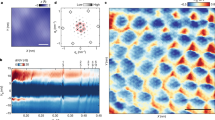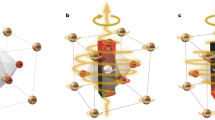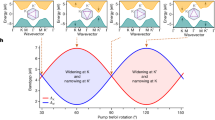Abstract
Graphene-based samples have shown a plethora of exotic characteristics and these properties may help the realization of a new generation of fast electronic devices. However, graphene’s centrosymmetry prohibits second-order electronic transport. Here, we show giant second-order nonlinear transports in graphene moiré superlattices at zero magnetic field, both longitudinal and transverse to the applied current direction. High carrier mobility and inversion symmetry breaking by hexagonal boron nitride lead to nonlinear conductivities five orders of magnitude larger than those in WTe2. The nonlinear conductivity strongly depends on the gate voltage as well as on the stacking configuration, with a giant enhancement originating from the moiré bands. Longitudinal nonlinear conductivity cannot originate from Berry curvature dipoles. Our theoretical modelling highlights skew scattering of chiral Bloch electrons as the physical origin. With these results, we demonstrate nonlinear charge transport due to valley-contrasting chirality, which constitutes an alternative means to induce second-order transports in van der Waals heterostructures. Our approach is promising for applications in frequency-doubling and energy harvesting via rectification.
This is a preview of subscription content, access via your institution
Access options
Access Nature and 54 other Nature Portfolio journals
Get Nature+, our best-value online-access subscription
$29.99 / 30 days
cancel any time
Subscribe to this journal
Receive 12 print issues and online access
$259.00 per year
only $21.58 per issue
Buy this article
- Purchase on Springer Link
- Instant access to full article PDF
Prices may be subject to local taxes which are calculated during checkout




Similar content being viewed by others
Data availability
The data that support the findings of this study are available within the paper and the Supplementary Information. Source data are provided with this paper. Other relevant data are available from the corresponding authors on reasonable request.
Code availability
The codes that support this study are available from the corresponding authors on reasonable request.
References
Novoselov, K. S. et al. Electric field effect in atomically thin carbon films. Science 306, 666–669 (2004).
Novoselov, K. S. et al. Two-dimensional gas of massless Dirac fermions in graphene. Nature 438, 197–200 (2005).
Zhang, Y., Tan, Y.-W., Stormer, H. L. & Kim, P. Experimental observation of the quantum Hall effect and Berry’s phase in graphene. Nature 438, 201–204 (2005).
Shen, Y.-R. The Principles of Nonlinear Optics (Wiley-Interscience, 1984).
Yankowitz, M., Ma, Q., Jarillo-Herrero, P. & LeRoy, B. J. van der Waals heterostructures combining graphene and hexagonal boron nitride. Nat. Rev. Phys. 1, 112–125 (2019).
Hunt, B. et al. Massive Dirac fermions and Hofstadter butterfly in a van der Waals heterostructure. Science 340, 1427–1430 (2013).
Yankowitz, M. et al. Emergence of superlattice Dirac points in graphene on hexagonal boron nitride. Nat. Phys. 8, 382–386 (2012).
Ma, Q. et al. Observation of the nonlinear Hall effect under time-reversal-symmetric conditions. Nature 565, 337–342 (2019).
Kang, K., Li, T., Sohn, E., Shan, J. & Mak, K. F. Nonlinear anomalous Hall effect in few-layer WTe2. Nat. Mater. 18, 324–328 (2019).
Sodemann, I. & Fu, L. Quantum nonlinear Hall effect induced by Berry curvature dipole in time-reversal invariant materials. Phys. Rev. Lett. 115, 216806 (2015).
Du, Z. Z., Wang, C. M., Li, S., Lu, H.-Z. & Xie, X. C. Disorder-induced nonlinear Hall effect with time-reversal symmetry. Nat. Commun. 10, 3047 (2019).
Isobe, H., Xu, S.-Y. & Fu, L. High-frequency rectification via chiral Bloch electrons. Sci. Adv. 6, eaay2497 (2020).
He, P. et al. Quantum frequency doubling in the topological insulator Bi2Se3. Nat. Commun. 12, 698 (2021).
Tokura, Y. & Nagaosa, N. Nonreciprocal responses from non-centrosymmetric quantum materials. Nat. Commun. 9, 3740 (2018).
Belinicher, V. I. & Sturman, B. I. The photogalvanic effect in media lacking a center of symmetry. Sov. Phys. Uspekhi 23, 199–223 (1980).
Gorbachev, R. V. et al. Detecting topological currents in graphene superlattices. Science 346, 448–451 (2014).
Xiao, D., Yao, W. & Niu, Q. Valley-contrasting physics in graphene: magnetic moment and topological transport. Phys. Rev. Lett. 99, 236809 (2007).
Song, J. C. W., Samutpraphoot, P. & Levitov, L. S. Topological Bloch bands in graphene superlattices. Proc. Natl Acad. Sci. USA 112, 10879–10883 (2015).
Stepanov, E. A. et al. Direct observation of incommensurate–commensurate transition in graphene-hBN heterostructures via optical second harmonic generation. ACS Appl. Mater. Interfaces 12, 27758–27764 (2020).
Wang, L. et al. One-dimensional electrical contact to a two-dimensional material. Science 342, 614–617 (2013).
He, P. et al. Nonlinear planar Hall effect. Phys. Rev. Lett. 123, 016801 (2019).
Ponomarenko, L. A. et al. Cloning of Dirac fermions in graphene superlattices. Nature 497, 594–597 (2013).
Dean, C. R. et al. Hofstadter’s butterfly and the fractal quantum Hall effect in moiré superlattices. Nature 497, 598–602 (2013).
DaSilva, A. M., Jung, J., Adam, S. & MacDonald, A. H. Transport and particle-hole asymmetry in graphene on boron nitride. Phys. Rev. B 91, 245422 (2015).
Wallbank, J. R. et al. Excess resistivity in graphene superlattices caused by umklapp electron–electron scattering. Nat. Phys. 15, 32–36 (2019).
Wallbank, J. R., Patel, A. A., Mucha-Kruczyński, M., Geim, A. K. & Fal’ko, V. I. Generic miniband structure of graphene on a hexagonal substrate. Phys. Rev. B 87, 245408 (2013).
Wu, S. et al. Multiple hot-carrier collection in photo-excited graphene Moiré superlattices. Sci. Adv. 2, e1600002 (2016).
Moriya, R. et al. Emergence of orbital angular moment at van Hove singularity in graphene/h-BN moiré superlattice. Nat. Commun. 11, 5380 (2020).
Woods, C. R. et al. Commensurate–incommensurate transition in graphene on hexagonal boron nitride. Nat. Phys. 10, 451–456 (2014).
Yang, W. et al. Epitaxial growth of single-domain graphene on hexagonal boron nitride. Nat. Mater. 12, 792–797 (2013).
Dean, C. R. et al. Boron nitride substrates for high-quality graphene electronics. Nat. Nanotechnol. 5, 722 (2010).
Das Sarma, S., Adam, S., Hwang, E. H. & Rossi, E. Electronic transport in two-dimensional graphene. Rev. Mod. Phys. 83, 407–470 (2011).
Duan, J. et al. High thermoelectricpower factor in graphene/hBN devices. Proc. Natl Acad. Sci. USA 113, 14272–14276 (2016).
Eckmann, A. et al. Raman fingerprint of aligned graphene/h-BN superlattices. Nano Lett. 13, 5242–5246 (2013).
Huang, M. et al. Giant nonlinear Hall effect in twisted WSe2. Preprint at arXiv:2006.05615 (2020).
Ortix, C., Yang, L. & van den Brink, J. Graphene on incommensurate substrates: trigonal warping and emerging Dirac cone replicas with halved group velocity. Phys. Rev. B 86, 081405 (2012).
Yankowitz, M. et al. Dynamic band-structure tuning of graphene moiré superlattices with pressure. Nature 557, 404–408 (2018).
Ribeiro-Palau, R. et al. Twistable electronics with dynamically rotatable heterostructures. Science 361, 690–693 (2018).
Battilomo, R., Scopigno, N. & Ortix, C. Berry curvature dipole in strained graphene: a Fermi surface warping effect. Phys. Rev. Lett. 123, 196403 (2019).
& Kumar, D. et al. Room-temperature nonlinear Hall effect and wireless radiofrequency rectification in Weyl semimetal TaIrTe4. Nat. Nanotechnol. 16, 421–425 (2021).
Finney, N. R. et al. Tunable crystal symmetry in graphene–boron nitride heterostructures with coexisting moiré superlattices. Nat. Nanotechnol. 14, 1029–1034 (2019).
Zhang, C.-P. et al. Giant nonlinear Hall effect in strained twisted bilayer graphene. Preprint at arXiv:2010.08333 (2020).
Stauber, T., Peres, N. M. R. & Guinea, F. Electronic transport in graphene: a semiclassical approach including midgap states. Phys. Rev. B 76, 205423 (2007).
Vasko, F. T. & Ryzhii, V. Voltage and temperature dependencies of conductivity in gated graphene. Phys. Rev. B 76, 233404 (2007).
Hwang, E. H. & Das Sarma, S. Acoustic phonon scattering limited carrier mobility in two-dimensional extrinsic graphene. Phys. Rev. B 77, 115449 (2008).
Ando, T. Valley Hall conductivity in graphene: effects of higher-order scattering. J. Phys. Soc. Jpn 87, 044702 (2018).
Novikov, D. S. Elastic scattering theory and transport in graphene. Phys. Rev. B 76, 245435 (2007).
Acknowledgements
We acknowledge K. Novoselov, A. Rodin and A. Carvalho for discussions. This work was partially supported by the National Research Foundation (NRF) Singapore Investigatorship (grant no. NRFI06-2020-0015). P.H. was sponsored by the National Key Research and Development Program of China (grant no. 2020YFA0308800), the Natural Science Foundation of Shanghai (grant no. 21ZR1404300) and start-up funding from Fudan University. The work at Massachusetts Institute of Technology was supported by the U.S. Army Research Laboratory and the U.S. Army Research Office through the Institute for Soldier Nanotechnologies, under Collaborative Agreement Number W911NF-18-2-0048.
Author information
Authors and Affiliations
Contributions
P.H., G.K.W.K. and H.Y. designed the experimental study. P.H. performed the measurements and analysed the data. G.K.W.K., J.Y.T., A.H.C.N. and J.H. fabricated devices. H.I. and L.F. performed theoretical studies. P.H., G.K.W.K., H.I. and H.Y. wrote the manuscript. All authors commented on the manuscript. H.Y. led the project.
Corresponding authors
Ethics declarations
Competing interests
The authors declare no competing interests.
Peer review
Peer review information
Nature Nanotechnology thanks Yuval Ronen and the other, anonymous, reviewer(s) for their contribution to the peer review of this work.
Additional information
Publisher’s note Springer Nature remains neutral with regard to jurisdictional claims in published maps and institutional affiliations.
Extended data
Extended Data Fig. 1 The second-order nonlinear transports in graphene honeycomb lattice with inversion symmetry breaking.
The second-order electric responses are schematically depicted for an ac electric field Eω (black) applied along a zigzag (a) and an armchair direction (b). The second-order current with double frequency J2ω (red) exists along the armchair direction for both cases. The three-fold rotational symmetry is schematically shown here with a rotation axis perpendicular to the plane and centered at a carbon atom, where the three dashed lines (equivalent crystalline axes) cross.
Extended Data Fig. 2 Tunability of nonlinear transport with gating in another superlattice device (Device 2).
a, b, The longitudinal resistivity ρxx (a) and Hall resistivity ρxy (b) as a function of back gate voltage Vg. c, d, The second-harmonic longitudinal \(V_x^{2\omega }\) (c) and transverse \(V_y^{2\omega }\) (d) voltage as a function of Vg at I = 3 µA. The data in (a), (c) and (d) are measured under zero magnetic field. The data in (b) are obtained at H = 0.5 T. e, f, The second-order nonlinear conductivities along the longitudinal \(\sigma _{{{{xxx}}}}^{\left( 2 \right)}\)(e) and transverse \(\sigma _{{{{yxx}}}}^{\left( 2 \right)}\)(f) directions as a function of Vg. All data are measured at T = 1.7 K. The misalignment angle between graphene and hBN in this device is similar to the one in the main text, as estimated from the Vg where SDP occurs.
Extended Data Fig. 3 Temperature dependence of the nonlinear transport in superlattice Device 2.
a, ρxx versus Vg measured at different temperatures under zero magnetic field. b, ρxx as a function of temperature for three gate voltages Vg, as marked by arrows in (a). c, The mobility as a function of temperature for three gate voltages. The data are obtained by measuring ρxx (Vg) and ρxy (Vg) simultaneously at H = 0.5 T. d, e, The extracted \(\sigma _{{{{xxx}}}}^{\left( 2 \right)}\)(Vg) (d) and \(\sigma _{{{{yxx}}}}^{\left( 2 \right)}\)(Vg) (e) at different temperatures. At Vg = −62.5 V, \(\sigma _{{{{yxx}}}}^{\left( 2 \right)}\)(Vg) shows a peak in (e). The data in (a), (b), (d) and (e) are obtained under zero magnetic field and I = 3 µA. (f) \(\sigma _{{{{yxx}}}}^{\left( 2 \right)}\) and μ3 as a function of temperature at Vg = −62.5 V.
Extended Data Fig. 4 The Fermi level dependence of linear conductivity.
The linear conductivity as a function of gate voltage Vg for Device 1 (a) and Device 2 (b). The data were measured at T = 1.7 K and H = 0 T. The arrows indicate the position of primary and secondary Dirac points.
Extended Data Fig. 5 The cubic scaling of nonlinear conductivity with mobility.
The nonlinear conductivity σyxx versus the cube of mobility for Device 1 (a) and Device 2 (b). The red lines are linear fittings to the experimental data. The error bars represent the standard deviation of the nonlinear conductivity.
Supplementary information
Supplementary Information
Supplementary Figs. 1–11 and Table 1.
Source data
Source Data Fig. 2
Statistical Source Data
Source Data Fig. 3
Statistical Source Data
Source Data Fig. 4
Statistical Source Data
Source Data Table 1
Statistical Source Data
Source Data Extended Data Fig. 2
Statistical Source Data
Source Data Extended Data Fig. 3
Statistical Source Data
Source Data Extended Data Fig. 4
Statistical Source Data
Source Data Extended Data Fig. 5
Statistical Source Data
Rights and permissions
About this article
Cite this article
He, P., Koon, G.K.W., Isobe, H. et al. Graphene moiré superlattices with giant quantum nonlinearity of chiral Bloch electrons. Nat. Nanotechnol. 17, 378–383 (2022). https://doi.org/10.1038/s41565-021-01060-6
Received:
Accepted:
Published:
Issue Date:
DOI: https://doi.org/10.1038/s41565-021-01060-6
This article is cited by
-
A tunable room-temperature nonlinear Hall effect in elemental bismuth thin films
Nature Electronics (2024)
-
Nonlinear transport and radio frequency rectification in BiTeBr at room temperature
Nature Communications (2024)
-
Creating chirality in the nearly two dimensions
Nature Materials (2024)
-
Room-temperature flexible manipulation of the quantum-metric structure in a topological chiral antiferromagnet
Nature Physics (2024)
-
Higher order gaps in the renormalized band structure of doubly aligned hBN/bilayer graphene moiré superlattice
Nature Communications (2024)



